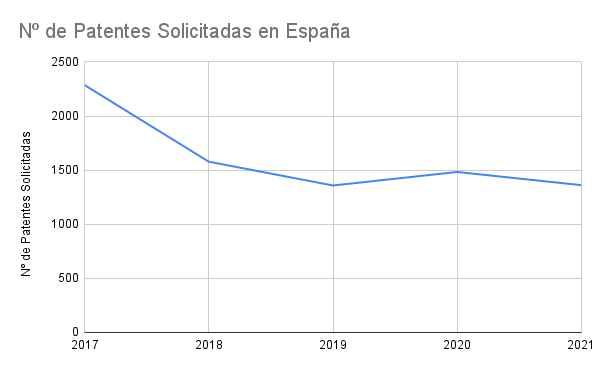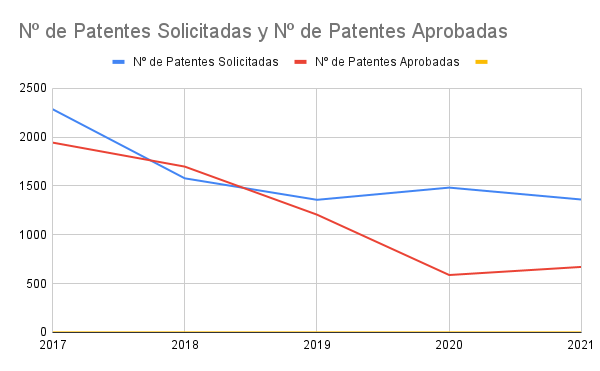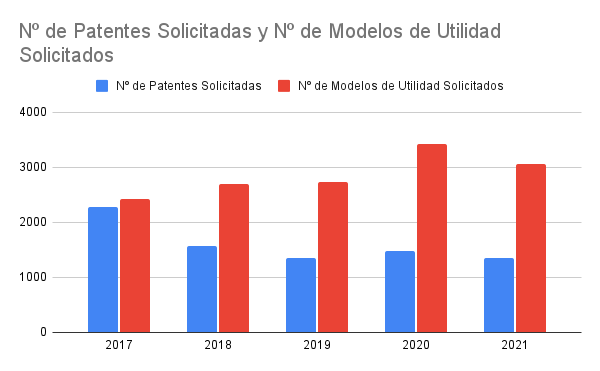HOW MUCH DOES IT COST TO PATENT AN IDEA?
In Spain, fewer and worse patents are filed.
Taking as a reference the public data in the SPTO, we can confirm that in 2021 almost 1000 fewer patents have been applied for in Spain than the number of applications registered in 2017.
I thought of a punctual and casual difference, but when downloading and projecting the data available in the SPTO, we have jumped all the alarms. Spaniards register on average almost 1000 fewer patents each year, compared to the annual averages of periods prior to 2017.

How many patents are approved each year in Spain?
Seeing such a notable decrease in the number of patent applications in Spain, I suspected: "The fewer applications, the better results we will have achieved compared to the OEPM" But this is not the case. The news is even worse. Not only do we apply for almost half of the Patents, but we are an increasingly worse applicant.
Before 2020, it was a trend for the community of inventors in Spain to achieve at least 80% of approvals of their patent applications, while, as of 2021, it has not been possible to reach 50% of success cases compared to the SPTO exams.
Did Spanish inventors disappear?
NO! Luckily, this anticipated conclusion is a big mistake. The community of inventors in Spain is kept alive, maintains ingenuity and creativity. At the same time that a radical change of trend is visualized in the number of patent applications in Spain, a substantial increase in the number of applications for Utility Models has been noted.
Of course, since the data does not lie, here is the graph that proves it:


Why do inventors apply for so many more Utility Models than Patents?
Lo primero que debo reafirmar, es que el Utility Model y la patent no son sinónimos. Tampoco es cierto que el Utility Model sea el antecedente de una Patente. Existen diferencias muy notorias entre una Patente y un Modelo de Utilidad. Aunque ya hemos profundizado en ese tema, te dejamos un cuadro resumen de las diferencias entre Modelos de Utilidad y Patentes.
Utility Model | patent | |
Protection | Useful improvement of something that already exists. Lack sufficient degree of inventiveness to be a patent | Complex inventions with high innovation load. They could also be initiatives that build on some existing element. |
Duration | 10 Years | 20 Years |
Substantive Review | The product or invention itself is not evaluated. It is evaluated that it complies with the formal structure | Whether there is a thorough assessment of the prior art and inventive step of the proposed invention |
Duration | 5 Months | 2 Years |
Internationalization | Very limited | Unlimited |
Market Price | 1500 € – 3000€ | 7000€ – 15000€ |
Taking a look at the comparison table, there is no doubt. Price can be one of the main motivations for inventors to choose to protect their inventions with a Utility Model rather than a Patent.
Calculate the Value of Your Patent
Are you ready to find out the estimated value of your Patent or Utility Model?
Do we have worse Inventors or worse Intellectual Property Advisors?
The numbers don't lie! The number of patent approvals is plummeting and decreasing much faster than the number of patents applied for in Spain. So we are substantially worse in some ways than we were a few years ago: we have worse inventors or worse intellectual property advisers.
I find it hard to think that the quality of Inventors has declined. During the last decade, in Let's Prototype, we have not noticed any phenomenon or trend that points to a decrease in the quality or creative capacity of our customers. In terms of volume of Inventors, if we add the Number of Patent Applications and the Number of Utility Model Applications, we will be in the best years of the community of Inventors in Spain, therefore, I have no doubt, those responsible for the great fall in approval of requested PATENTS, has more to do with the advisors than with the inventors themselves.

If we analyze again the graph of Patents Applied for Vs. Approved Patents, it calls into question those responsible for: evaluating the patentability options of inventions, preparing robust and professional reports, studying antecedents and creating solid protection strategies. I work hand in hand with professionals in the sector in Spain and I can only praise their dedication and high level of commitment, but, unfortunately, professional intrusion in the sector is being a great threat to the level of the community of inventors in Spain.
How to distinguish between a good and a questionable advisor?
It would be very unfair to question intellectual property professionals. I work hand in hand with professionals in the sector in Spain and I can only praise their dedication and high level of commitment. In this case, just by appealing to our professional experience, feedback from inventors and footprint in the sector, we provide you with a comparative table of common features between the best intellectual property advisors we know and with whom we collaborate systematically and those we choose least.
Good Advisors | Less recommended advisors. | |
Specialization | High: They are dedicated exclusively to intellectual property work | Low: They include a much broader list of services than patents. |
Background | They often find results that threaten or come close to your invention. They analyze their characteristics and create a protection strategy. They report on it. | You will never find threats or patents similar to your invention. They are the fastest and cheapest doing background searches. |
Registration Method | They have a balanced number of filings between Patents and Utility Models | They have many more applications for Utility Models than Patents in their history |
Transparency | They give you the opportunity to put your contact details, address and any identification on your invention. | Without asking anything, they register you as an inventor but register the addresses of their offices. This prevents other providers from contacting you. |
We really make a great effort to locate, analyze and synthesize useful information for your career as an inventor. We do it because we are aware of how much is at stake in every decision. If in any way, you want to start our effort in information, share this post in your networks and leave us a review about your opinions about the work done.
Do you want to turn your idea into a product?
The time to bring your ideas to life is now. We accompany you throughout the entire process: from idea to product.
San Juan Ingenieros, S. L, is the owner of the domain www.letsprototype.com, and in accordance with the General Data Protection Regulation (EU 1679/2016), we will process your data exclusively to handle your information request. You have the right to rectify or request the deletion of your data at any time via hello@letsprototype.com.
Recent Posts
5/5 - (4 votes)
Business Director - Inventors' Advisor at Let´s Prototype
Erick Remedios has been linked to entrepreneurship and the launch of innovative projects and inventions for over a decade. His start in the entrepreneurship sector began as the Project Management Director at the network of Private Investors, Business In Fact, S.A., a club of private investors specialized in high-risk investments, which he ended up managing as General Director for at least 5 years.
As the director of the Private Investors network specialized in innovative projects in the startup phase, Erick Remedios participated in more than 40 investment operations, with his main functions being: advising entrepreneurs and inventors, as well as private investors interested in investing in such projects.
Erick Remedios has been one of the influential figures in the development of the ecosystem of entrepreneurs and private investors in Spain. Since 2012, he has participated in numerous private investment forums, has advised entrepreneurial projects as a member of their Boards of Directors, and has served as a lecturer in numerous Public and private Universities, specialized public centers in entrepreneurship, and internationally leading business schools, such as It Aérea Business School, where he leads the management of the Business Model Design Module for entrepreneurs, mostly Aerospace Engineering graduates.
Specialized Centers in Entrepreneurship and the Launch of Innovative Projects where Erick Remedios has participated:
- Direction of the Program - Sanse Emprende from the City Council of San Sebastián de los Reyes, Madrid.
- Direction of the Espoban Program – Diputación de Córdoba and European Center for Business Innovation. Training of entrepreneurs and inventors and preparing them to attract capital through private investors.
- Speaker on the subject of launching innovative projects at Universities such as: Pablo Olavide, University of Seville, University of Málaga, University of Cádiz, University of Huelva, University of Almería, University of Jaen, University of Granada.
- Direction of the Entrepreneurship Module – IT Aérea Business School.
- ENyD Business School: Professor and lecturer in the area of Entrepreneurship and Private Investment.
- Avanza Castellón - Mentor of entrepreneurs and inventors in the program of the Diputación de Castellón.
- Ávila Emprende – Program of the City Council of Ávila. Mentor of entrepreneurs in sales processes and product development.
- Aula UGR- Professor of entrepreneurship and management of launching innovative projects in programs aimed at training teachers from the University of Granada.
- Master Up - Professor of entrepreneurship and investment management in the Official Master's for entrepreneurs from the University of Cadiz.
At the same time, numerous companies have signed Erick Remedios as an advisor and member of their Board of Directors, companies in which Mr. Remedios has also acted as the representative of the private investors who have placed their trust and economic resources, including:
- Tu Fabrica de Eventos
- Baby Radio
- Graffos
- Neurobia Research
- HitsBook
- Bit Credit
- Glelemo
Currently, Mr. Remedios is leading the international expansion of Let´s Prototype in the United States, while also advising inventors on startup processes for projects related to innovative Hardware or Software elements, both in terms of product design, a specialty of Let´s Prototype, and in terms of designing strategies for selling inventions and patents.
Interviews with Mr. Remedios and publications authored by him in Media:
- School of Business and Management: [Link](https://www.youtube.com/watch?v=ch3nRTFvxhw)
- Diputación de Córdoba. Training for Investors: [Link](https://www.youtube.com/watch?v=Cj2fvxkD-zI)
- Spanish Television - Program Emprende: [Link](https://www.youtube.com/watch?v=vZRi98CE20M)
- TV2 - Spanish Television: [Link](https://www.youtube.com/watch?v=ms22bxyllKc)
- University of Cadiz: Article for Inventors: [Link](https://emprendedores.uca.es/lean-prototyping-el-puente-entre-el-concepto-el-prototipo-y-las-patentes/)
- University of Granada: Article for Inventors: [Link](https://ugremprendedora.ugr.es/6-tips-para-convertir-tu-idea-o-concepto-en-prototipo-lean-prototyping/)
Latest posts by Erick Remedios (see all)
- Product Restyling: What Is It and What Is It For? - June 25, 2025
- What is Rapid Prototyping? - June 25, 2025
- Guide to Product Packaging Design. Packaging Examples. - June 13, 2025

